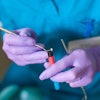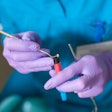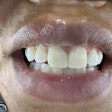Combining subepithelial connective tissue grafting with immediate tooth replacement can reduce gingival recession following a tooth implant, according to a study in the Journal of Oral Implantology (October 2011, Vol. 37:5, pp. 559-569).
While a single tooth replacement performed as an immediate, one-step process is an accepted procedure, gingival recession occurs more often with this implant method, noted the study authors, from Loma Linda University School of Dentistry.
They reported on a case series of 10 patients who received a single immediate tooth replacement in conjunction with subepithelial connective tissue graft.
In the immediate tooth replacement procedure, a failing tooth is removed and an implant is immediately placed into the socket. For the tissue graft, tissue is harvested from the palate using a single incision. The graft material is inserted into a prepared space between the labial bony plate and the gingiva of the extraction site. The graft preserves soft tissue levels, making the gingival tissue less likely to recede, according to the researchers.
In this study, patients were evaluated before surgery, at the time of tooth replacement, and at three, six, and 12 months after surgery. One implant failed early in the process, but at one year the remaining nine patients showed good integration of tissue and tooth with minimal loss of marginal bone level or facial gingival level.
With proper implant position and the placement of graft material, a favorable success rate can be achieved, the researchers concluded.



















